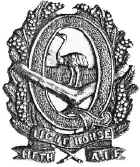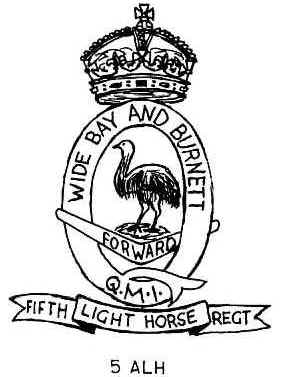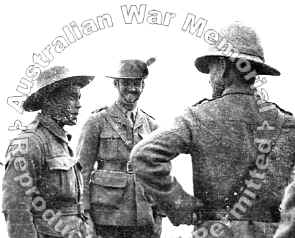 |
| Category:
Lt Horse Regiments |

|
|
|
|
|
|

5th
Light Horse Regiment (Queensland)
[2nd
Light Horse Brigade]
Served in Egypt, Gallipoli, Sinai, Palestine

|
 |
|
Badges displayed either
unofficial or CMF.
|
 |
| Side view of men of
the 5th Australian Light Horse Regiment, on alert, in a section of
the bridgehead. This bridgehead, established on the eastern side
of the Jordan after the first Amman raid, was retained throughout
the summer. The Turks suffered severely in an attempt to capture
it by night from the 1st Light Horse Brigade in April 1918. |
 |

|
Private
William Edward (Billy) Sing DCM, 31st Battalion, of Clermont, Qld,
who enlisted on 26 October 1914 and returned to Australia on 21
July 1918. While serving with the 5th Light Horse Regiment on
Gallipoli, Trooper Sing acquired notoriety as an accurate sniper,
shooting over 150 Turkish soldiers. |
| Egypt,
1915. Lieutenant-General Sir William Riddell
Birdwood, at right with his back to the camera, talking to the
famous Gallipoli sniper, Trooper William Edward
("Billy") Sing (left), 5th Light Horse Regiment. Sing,
nicknamed "the Murderer", was reputed to have shot over
150 Turkish soldiers at Gallipoli. The identity of the soldier
between Trooper Sing and General Birdwood is unknown.
(Donor D. De Celis) |
Trooper
Sing sniped from a position at Chatham's Post, his tally stated as
150 confirmed, but a higher informal estimate puts his tally at
201. The discrepancy can be accounted for by the way such hits
were recorded. On 23 October 1915, General Birdwood issued an
order containing his compliments on Trooper Sing's performance
accounting for the 201 Turks. Private Sing was awarded the
Belgian Croix de Guerre in early 1918, probably for his role in
leading a patrol eliminating some German snipers at Polygon Wood
in September 1917.
|
Battle Honours:
-
Anzac,
-
Defence of Anzac,
-
Suvla,
-
Sari
Bair,
-
Gallipoli 1915,
-
Romani,
-
Egypt 1915-17,
-
Gaza-Beersheba,
|
-
El Mughar,
-
Nebi Samwil,
-
Jerusalem,
-
Jordan (Es Salt),
-
Jordan (Amman),
-
Megiddo,
-
Nablus,
-
Palestine 1917-18
|
|
many details on this page from Ross
Mallett's site
|
5th Light Horse Regiment
The 5th Light Horse Regiment was
raised in Brisbane in September 1914, entirely from men who had
enlisted in Queensland, and became part of the 2nd Light Horse
Brigade. Sailing from Sydney on 21 December 1914, the regiment
disembarked in Egypt on 1 February 1915.
The light horse were considered
unsuitable for the initial operations at Gallipoli, but were
subsequently deployed without their horses to reinforce the
infantry. The 2nd Light Horse Brigade landed in late May 1915 and
was attached to the 1st Australian Division. The 5th Light Horse
played a defensive role for most of the campaign but was involved in
several minor attacks. It left the peninsula on 20 December 1915.
Back in Egypt, the 2nd Light Horse
Brigade became part of the ANZAC Mounted Division and in February
1916 joined the forces defending the Suez Canal from a Turkish
advance across the Sinai Desert. The 5th Light Horse’s main
activity in the Sinai was long-range patrolling, but it was involved
in several small engagements during August, as the Turks retreated
after their defeat at Romani.
The ANZAC Mounted Division
advanced into Palestine in late December 1916. The 5th’s work
predominantly continued to be patrols and raids until the advance
stalled before the Turkish bastion of Gaza. The regiment
participated in all three battles aimed at capturing the town, most
notably the first abortive attempt on 27 March 1917. On this
occasion the 5th attacked Gaza from the rear and was fighting its
way through streets and gardens when ordered to withdraw.
With the fall of Gaza on 7
November 1917, the Turkish position in southern Palestine collapsed.
The 5th was involved in the pursuit that followed, and then spent
much of the first half of 1918 holding the west bank of the Jordan
River. During this time it was involved in the Amman (24–27
February) and Es Salt (30 April–4 May) raids, both of which were
tactical failures but helped to convince the Turks that the next
offensive would be launched across the Jordan.
Instead, the offensive was
launched along the coast in September 1918, with the 5th taking part
in a subsidiary effort east of the Jordan. It attacked at Amman on
25 September, and on 29 September 4,500 Turks surrendered to just
two squadrons from the regiment at Ziza. Turkey surrendered on 31
October 1918, but the 5th Light Horse was employed one last time to
assist in putting down the Egyptian revolt of early 1919. It sailed
for home on 28 June 1919. Text from AWM
- 137 killed, 708 wounded
-
Decorations
- 1 CB
- 3 CMG
- 4 DSO
- 9 MC
- 1 CBE
- 6 DCM
- 18 MM
- 1 MSM
|
|
|